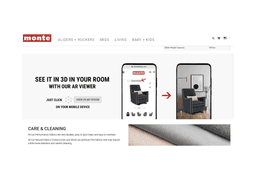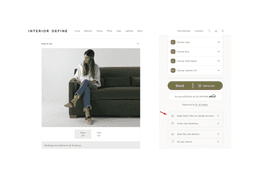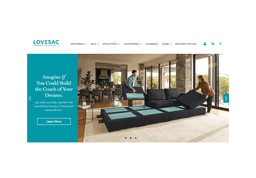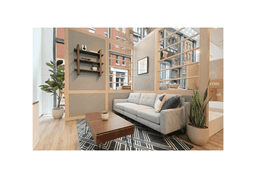How Can Furniture Brands Get Onboarded on DTC Ship in 2023?
Sector: Digital Commerce
Author: Nisarg Mehta
Date Published: 10/11/2022

Contents
- Post-Pandemic World of Furniture
- What is D2C?
- What Does D2C Mean for Furniture Businesses?
- Enables Omnichannel Capability
- Builds Better Brand Image
- Delivers End-to-End Customer Experience
- Ensures Improved Control Over Prices
- Provides Distribution Control
- Makes Customer Data Accessible
- Helps Compete with Established Furniture Brands
- How Furniture Brands Should Move Forward With D2C
- Top D2C Furniture Brands
- Time to Go D2C
Consumer buying behavior across every category has been dramatically affected by COVID-19, and the furniture niche is no exception.
As a result of the new ‘stay-at-home’ lifestyle, consumers have been spending more time and money on home improvements and are forced to shop online. Because many furniture retailers were already using online services as one of their marketing strategies, they were better prepared for this eventuality.
However, many furniture businesses have been caught flat-footed, unable to deliver a positive digital experience as they have delayed digital transformation. At the same time, these furniture brands were scrambling to solve supply chain issues and find new retail partners.
Due to the challenges faced in odd times, many furniture brands are now considering testing the direct-to-consumer (D2C) business model.
Now, what is D2C, and what does it mean for furniture brands? And most importantly, how should furniture brands move forward with D2C?
We’ll discuss all such crucial questions in this article. Let’s start with the pandemic’s impact on furniture brands.
Post-Pandemic World of Furniture
The old notion that you can’t sell every product online has been disproved.
According to Statista, online furniture websites selling home decor and related items experienced 1.7B visits in March 2020, up from 1.56B global visits in January 2020.
Furniture retailers are adopting digital strategies to respond to global behavioral change. According to a survey by Furniture Today, 69% of respondents plan to increase their e-commerce business in response to the COVID-19 virus.
In the post-pandemic world, traditional retailers that had lost focus on online sales are now attempting to develop engaging online stores and websites. Other online retailers that had previously opened online stores are using different techniques to help boost their furniture sales and pave the way for future success, and one such technique is direct-to-customer, aka D2C.
What is D2C?
In D2C commerce, manufacturers/producers sell their goods/products directly to consumers. The D2C commerce framework disposes of the middleman directly. Brands may either sell directly to consumers through their official websites or sell directly through retail stores as a result of bypassing retailers.
The D2C model has been around for a decade. Companies such as Warby Parker, Casper, and Everlane, among others, were among the first furniture brands to experiment with it, relying on web-only retail, direct distribution, distinctive visual identities, and social media marketing.
What Does D2C Mean for Furniture Businesses?
A Canadian D2C furniture brand, Article said that its sales increased by 200% in April 2019 compared to the same period in 2018. This gave them their highest revenue month ever.
Many other digitally-native D2C brands managed to weather the storm of the pandemic because of their online sales-centric business model. These brands remained unaffected by the impact of the coronavirus outbreak owing to their engaging online presence and established processes.

D2C holds a lot of value for furniture brands. Following are the most commonly realized benefits of D2C for the furniture industry.
Enables Omnichannel Capability
73% of customers use multiple channels during their purchase journey – Harvard Business Review.
This means customers expect omnichannel commerce to be the norm everywhere they shop, and the same goes for furniture brands.
An omnichannel commerce setup requires connecting all of the digital and physical stores via a centralized e-commerce platform. The good news is that building an omnichannel experience isn’t a distant dream. E-commerce experts like Techtic can help you build omnichannel functionality for your business.
Builds Better Brand Image
Obviously, there are quite a few disadvantages associated with selling through a retailer network. Branding control is one of them. Even though you don’t white label products to your retailers, the fact that you don’t control customer communication detracts from your brand image.
On the flip side, as D2C brands speak with customers and serve them directly, they can tell their brand story in the way they want. In addition, they receive customer feedback immediately.
Delivers End-to-End Customer Experience
As discussed earlier, even if you have the most imaginative digital merchandising ideas, you cannot control the customer experience that your retailers provide. The customer experience throughout the D2C furniture brand’s life cycle is always controlled by the brand itself.
One of the main reasons why D2C furniture brands are successful is because they have a flawless and smooth user experience. Product configurators, 360-degree views, product suggestions, user-generated content, and customer reviews are just a few of the features that help users convert to the perfect product page.
Ensures Improved Control Over Prices
When you work with a D2C model, you don’t have control over the final cost. As a result, not only does profit margin get affected, but also your product’s positioning.
Expanding your perspective on the overall costs and enhancing it to the point where you may establish pricing for different product lines is one of the advantages of working with a D2C model. D2C allows furniture brands to establish pricing strategies regardless of whether they want to target low-cost goods or include high-end goods with higher prices.
Provides Distribution Control
Problems in the supply chain can cause serious delays for consumers. Furniture brands have to send products through several levels to the end user. The delivery pipeline includes wholesalers, retailers, and other middlemen.
The longer your supply chain is, the more susceptible you are to issues. Everyone down the line is affected when there is a problem in one link.
In contrast, D2C furniture brands have a much lower risk of supply chain problems than traditional brands. The entire supply chain is either handled by the D2C firm or outsourced to a reliable fulfillment service (i.e., Amazon Fulfillment) which eliminates the supply-chain gaps.
Makes Customer Data Accessible
Even if we set aside the cliché “data is the new oil,” we must acknowledge that data may be the most successful resource a corporation has. You might lose a lot of money by basing your decisions on a ‘gut feeling’ rather than on advanced analytics tools.
Unlike conventional furniture companies, D2C furniture companies own the entire CRM, sales, and customer support data. You can collect data that shows how customers behave, what they purchase, and what they think to improve your sales and customer support across the board.
Personalization is everything today, and you can get more conversions by customizing your approach based on customer data. If you know who your customers are and what they want, you can easily tailor your approach to their needs and gain more sales.
Helps Compete with Established Furniture Brands
Traditional furniture brands may blend into the crowd, but D2C brands stand out. Because D2Cs are not constrained by retailers’ interpretations of their merchandise, they may express their unique values in a creative manner. However, D2Cs must convince consumers that they can provide something unique.
Furthermore, when buying from a D2C brand, consumers don’t have to follow what retailers believe are popular products. D2C furniture brands can offer customers more alternatives that may entice them to visit the site more and make a purchase.
How Furniture Brands Should Move Forward With D2C
The benefits of D2C for furniture brands are enticing. Here is how a furniture business can get started with D2C:
1. Know Your Customer and Their Needs
The first thing to consider when going direct to the consumer is that you are no longer working with a third party to connect with your customers. You, therefore, have to be familiar with your customers, understand their needs, and address their concerns.
D2C furniture brands should decide on the following aspects during their early stage:
- Defining the target audience and creating buyer personas
- Understanding the ideal customers’ needs
- Analyzing the competitors
- Creating clear brand positioning
2. Create or Improve Your Product Lines
The greatest advantage of the D2C approach is that you discover what customers want and concentrate on your strengths. Many successful D2C firms have a certain niche they’re well-versed in, and they can provide extra value for their clients.
Whether it’s a sofa, mattress, or outdoor furniture, building your business by starting with your strongest skills and then slowly expanding your services as you gain customers’ confidence is the most effective way to expand your D2C furniture company.
3. Choose the Right Technology Stack
All D2C furniture brands that are successful rely on technology to provide engaging shopping experiences. However, an efficient tech stack requires careful deliberation. Some of the technologies that companies must use if they want to experiment with the D2C model include:
- A strong e-commerce platform
- Product visualization
- CRM and marketing software
- Order fulfillment platform
- A data analysis stack
- Personalization engines
Ideally, a furniture company that depends on technology to expand its business should use 3D product visualization and augmented reality to enhance engagement on its website, increase conversions, and reduce visualization expenses.
Today’s customers are comparing you to the best digital experiences they’ve ever had, constantly raising their expectation bars. D2C brands are digitally native, so using technology as a competitive advantage is expected. Future-proofing your business and making it more resilient in future outbreak scenarios may be accomplished using the best technology stack.
Most furniture businesses don’t have expertise in this segment. Hence, it’s always recommended to partner with a technology service provider like Techtic, who can help you implement the best combination of technologies.
4. Avoid Severing Ties with Existing Retailers and Wholesalers
When adopting D2C, furniture brands don’t necessarily have to choose between wholesale, retail, and direct-to-consumer strategies. Using all channels for sales and marketing is also an option.
In fact, retailers and wholesalers often disagree when one of their brands moves to direct-to-consumer marketing. However, brands can overcome this problem by communicating externally in an effective and transparent fashion.
5. Partner for Order Fulfillment
D2C brands require last-mile delivery of their products. However, a big issue for D2C businesses is the return of items purchased digitally. In fact, there has been a sharp rise in the number of goods returned in 2021, up from $428 billion in the previous year to $761 billion.
Working with logistics services such as Amazon Fulfillment is usually a better idea when experimenting with D2C. Be it any case, D2C brands would have to invest in 3PL firms or inventory management systems (IMS) to better manage return expenses for their online stores.
6. Focus on Delivering a Top-Notch CX
You must create an excellent customer experience if you want to succeed in the D2C business model. As there are already some big players on the field, you should not think that you can enter a school of sharks and play by their rules to win; you will not stand a chance.
D2C firms are excellent at exceeding expectations using creativity. Hence, instead of following what retailers or other D2C firms do, establish your own rules and establish the bar in customer satisfaction. However, there is no harm in learning from their strategies and using the improvised version.
Top D2C Furniture Brands
Following are the top 3 furniture brands that are flourishing via the D2C approach:
Monte Design

Since 2006, Monte Design has been producing high-end furniture for both adults and children. Monte Design sells its furniture through its own channels as well as through retail partners.
Monte’s employees are committed to gorgeous design, superb quality, and exceptional customer care.
When you click on their website’s product pages, you can immediately see Monte Design’s dedication to providing a custom online shopping experience. Monte Design uses high-quality 3D product visualization to bring products to life.
Interior Define

Interior Define was created in 2014 to provide consumers with custom-made sofas at a competitive price. Ever since the brand has been at the forefront of furniture industry innovation.
In addition to providing customers with product visualization, Interior Define provides online and offline consultations with local design experts to help them throughout the purchasing process.
Lovesac

Lovesac, a Stamford, Connecticut-based D2C furniture company, designs, manufactures, and sells high-quality furniture through a proprietary approach called “Designed for Life.” The company has created a mobile concierge service to provide customers with a custom shopping experience right at their doorstep.
Customers can receive a demo to view and feel a variety of fabric options, configure a setup that suits their space and style, and place an order with fast and free shipping during the Mobile Concierge appointment.
Burrow

Burrow was created in 2016 with the goal of revolutionizing how individuals furnish their dwellings. The founders started Burrow with a fresh approach to furniture, ensuring that quality, affordability, and convenience were not sacrificed.
Burrow is one of the most successful D2C furniture brands today. In addition to their thriving online business, they ventured into physical retail, but with a twist.
The Burrow House in Soho is an excellent example of a brick-and-mortar store functioning as a showroom for products while also hosting events and partnering with other brands.
Customers may purchase Clare and The Sill’s items at the Burrow showroom, which are two additional D2C brands that don’t sell the same products as Burrow. The retail roommates resulted in a triple win. Customers were able to purchase furniture and plants, in addition to paint, at a single location, saving time and getting great exposure for Clare and The Sill.
Time to Go D2C
D2C is the future for furniture brands. Of course, every furniture brand will have its own strategy, but D2C will remain at its core.
The aforementioned example of the most innovative D2C brands should be enough to get you motivated on your road to a direct-to-customer strategy.
For technology-related consultation, you can reach out to us. We specialize in omnichannel retail platform development and front-end technologies. Book your consultation here.



